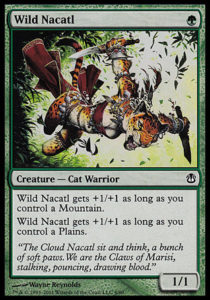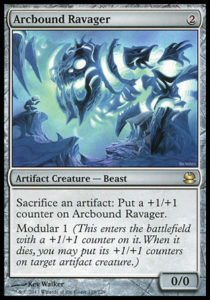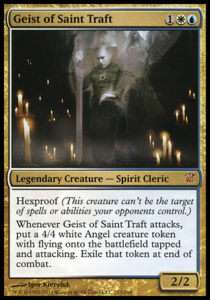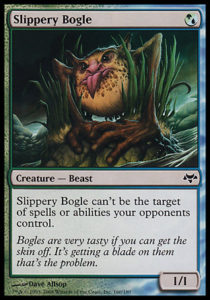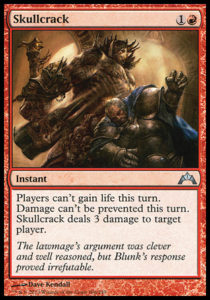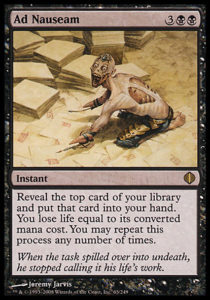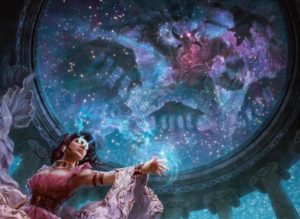I’m home from Richmond. It was my first ever Constructed Grand Prix. ’twas also my first ever Day Two at a Grand Prix. Had I won one more match, it most likely would have been the first time I’d ever won paper money playing Magic. It was an exhaustively fun weekend, full of wonderful people and this game that I love playing, winning, and losing.
I could bore you all with a tournament report (there’ll be a decklist and my matchups next week if you do), but that’s not my style. I’d rather thank a small portion of the folks who taught me success in anticipation of the tournament. Each and every one of them taught me a deck that I played against at the tournament and what my deck (UWR Geist) needed to succeed. So without further ado, here are some short stories/thanks.
Chase recently acquired Tribal Zoo and allowed me to both test with and against it. It didn’t take long to learn that Zoo is just a better (i.e. faster) burn deck than UWR Geist. Accordingly, I lost a fair amount (and learned much from it). In this matchup, I need to play the control, but unlike actual UWR control (with [casthaven]Sphinx’s Revelation[/casthaven], [casthaven]Batterskull[/casthaven], or [casthaven]Vedalken Shackles[/casthaven] in the main), I can never take control of the game; eventually, I’ll run out of removal and die to a [casthaven]Kird Ape[/casthaven] or [casthaven]Knight of the Reliquary[/casthaven]. In the end, I still need to stick a [casthaven]Geist of Saint Traft[/casthaven] and race.
This was perhaps the most important lesson for the weekend (which was full of aggro and combo): no matter what, I can never side out all copies of [casthaven]Geist of Saint Traft[/casthaven]. Geist is my win condition. The goal of UWR Geist is simple: let an opponent take 3-7 damage off of his or her lands, take 10-12 damage off of Geist of Saint Traft, and then use [casthaven]Celestial Colonnade[/casthaven], [casthaven]Vendilion Clique[/casthaven], [casthaven]Lightning Bolt[/casthaven], [casthaven]Lightning Helix[/casthaven], or [casthaven]Snapcaster Mage[/casthaven] to finish the job (with [casthaven]Restoration Angel[/casthaven] and [casthaven]Thundermaw Hellkite[/casthaven] being singleton aids to this cause). Burn is primarily for killing aggro’s creatures and it’s unusual often (though not unheard of) that I’ll throw three or more burn spells at an aggro opponent’s face.
In addition to driving me to the GP and smashing her way to day two, Dana lent me Robots for Tuesday Night Modern last month. The deck’s a powerhouse that demands sideboard slots from every deck in Modern. Its weakness (main deck) is playing terrible cards like [casthaven]Memnite[/casthaven], [casthaven]Ornithopter[/casthaven], and [casthaven]Signal Pest[/casthaven] in order to turn its primary engines, [casthaven]Arcbound Ravager[/casthaven] and [casthaven]Cranial Plating[/casthaven], into absurdly powerful cards. The deck requires a skilled pilot, since incorrect sequencing leads to slow starts and slow starts are fatal.
For my deck, Affinity is like Zoo, except for [casthaven]Cranial Plating[/casthaven] (which requires me to kill every last creature) and the unkillable [casthaven]Etched Champion[/casthaven] which puts me on an unstoppable clock. Also, it takes no damage off its lands.
In short, Robots is a rough game one unless I can stop [casthaven]Cranial Plating[/casthaven], kill all of its creatures, or race with [casthaven]Geist of Saint Traft[/casthaven]. After board, I have a ton of powerful options, but sometimes I’ll draw [casthaven]Stony Silence[/casthaven] when I need to stop an army of weenies, draw [casthaven]Anger of the Gods[/casthaven] when I need to block an [casthaven]Etched Champion[/casthaven], or draw [casthaven]Spellskite[/casthaven] when [casthaven]Cranial Plating[/casthaven] is on a 7/1 [casthaven]Signal Pest[/casthaven]. Sometimes you’ll draw the right sideboard card at the right time. Sometimes you won’t and you’ll lose. Robots was my worst and most common matchup at Richmond, and I went 1-3 against it. Just gotta get more practice in for next time!
Derek and I jammed the UWR mirror a whole bunch of times. The matchup is simple: whoever sticks a Geist almost always wins. If there’s no Geist, or if your opponent has a Geist, a pile of [casthaven]Snapcaster Mage[/casthaven]s and [casthaven]Lightning Helix[/casthaven] can win the race.
The mirror is a staring match. If you play Geist first, it’ll probably eat a [casthaven]Mana Leak[/casthaven] and your opponent will be free to resolve his or her own Geist (a terrible situation). If you slam Geist and they don’t have a counterspell (usually UWR has only four to six two mana counterspells), you win. If you’re on the play with [casthaven]Vendilion Clique[/casthaven], [casthaven]Mana Leak[/casthaven] or [casthaven]Remand[/casthaven], and [casthaven]Geist of Saint Traft[/casthaven] in hand you’re guaranteed to either resolve a Geist or resolve a Clique (which, in the worst case, eats a [casthaven]Lightning Bolt[/casthaven] and takes your opponent’s worst card or lets you know that the coast is clear).
As I waited for my players’ meeting, Matt Jones and I jammed several games with his Bogle deck. I was led to believe that the matchup is nearly unwinnable. Testing proved that game one is hard (I didn’t win a single game against Matt) and that postboard, an unanswered [casthaven]Spellskite[/casthaven] wins the game by itself. Turns out, you can win game one by aggressively countering [casthaven]Ethereal Armor[/casthaven] and [casthaven]Rancor[/casthaven] (the big power-buffers) and burning your opponent’s face. In the end, only one card matters: [casthaven]Daybreak Coronet[/casthaven]. Always have [casthaven]Spell Snare[/casthaven] or [casthaven]Mana Leak[/casthaven] up for it. If you can keep a Bogle player from gaining life, you can win. Once they gain life, you can’t win the race. Thanks to Dr. Jones (and some luck), I was able to 2-0 my match against Bogles.
Zac Clark and I jammed UWR versus Burn. It’s one of UWR’s best matchups, as long as you know two rules:
1. Only take damage from lands if it prevents the same amount of damage (for example, taking two off of [casthaven]Steam Vents[/casthaven] to [casthaven]Lightning Bolt[/casthaven] a [casthaven]Goblin Guide[/casthaven]). It’s rarely worth it to take two damage to kill an attacking [casthaven]Grim Lavamancer[/casthaven]. Also, recognize that fetch lands don’t need to be cracked immediately.
2. Protect [casthaven]Lightning Helix[/casthaven] from [casthaven]Skullcrack[/casthaven]. If you resolve two Helices, it’s almost impossible to lose. If you walk one into a ‘crack, you just lost the most important part of the spell.
My final thanks in this half is against to Zac Clark. He played storm for a while, and while its combo is completely unlike [casthaven]Ad Nauseam[/casthaven]’s (which I’d heard of, but never encountered prior to my match against it on day two), the rules are the same.
1. Know when the combo can happen. Storm can potentially go off on turn three, so jamming a [casthaven]Geist of Saint Traft[/casthaven] (without using [casthaven]Vendilion Clique[/casthaven] first) can be fatal. Ad Nauseam, however, requires five or six mana (six with an [casthaven]Angel’s Grace[/casthaven], five if it uses [casthaven]Phyrexian Unlife[/casthaven]), so barring a [casthaven]Lotus Bloom[/casthaven] or [casthaven]Pentad Prism[/casthaven] it can’t go off until turn five (potentially on four with a [casthaven]Simian Spirit Guide[/casthaven], and it can only use one since it needs the other three to cast [casthaven]Lightning Storm[/casthaven]). In short, there’s time to develop a board before fighting over this combo.
2. Know how to disrupt the combo. Storm has a hard time going off without [casthaven]Goblin Electromancer[/casthaven] and [casthaven]Pyromancer Ascension[/casthaven]. [casthaven]Ad Nauseam[/casthaven] can’t go off without six mana and it can’t protect itself without [casthaven]Boseiju, Who Shelters All[/casthaven] or [casthaven]Pact of Negation[/casthaven]. If you can keep Ad Nauseam from obtaining enough mana or sculpting a good enough hand, you can win.
Having never seen the deck in action, I made some mistakes ([casthaven]Cryptic Command[/casthaven] bouncing Boseiju can be devastating). Were I to play it again today, I believe that my thrashing on day two taught me how to win.
That’s all for now. Next week I’ll tell you about RUG, Twin, the Rock, and how I almost [casthaven]Lightning Bolt[/casthaven]ed my own [casthaven]Geist of Saint Traft[/casthaven] in my win-and-in. As always, thanks for reading!
—Zachary Barash
twitch.tv/ZennithGP — Join the livestream!
Magic Online username: Zennith
Zachary Barash has been playing Magic on and off since 1994. He loves Limited and drafts every available format (including several that aren’t entirely meant to be drafted). He’s a proud Cube owner and performer, improvising entire musicals every week with his team, Petting Zoo. Zach has an obsession with Indian food that borders on being unhealthy.

